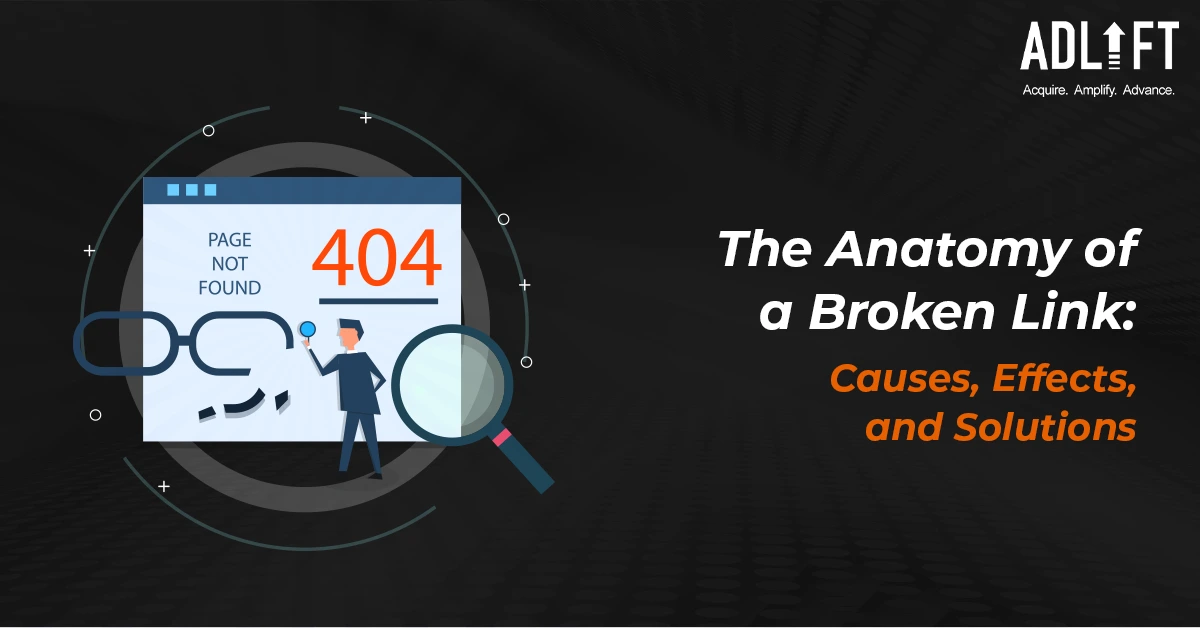The Anatomy of a Broken Link: Causes, Effects, and Solutions

In the vast expanse of the internet, links function as the binding threads that interlace the entire web. They guide us from one corner of the digital realm to another, enabling seamless exploration of information, services, and entertainment. Yet, just like any intricate structure, even the most robust web of links can develop weak spots. If you manage a website or do regular scrolling, you might encounter weak spots or errors like Timeout, Reset, 404 Page Not Found, 400 Bad Request, etc. These are error codes that a web server may present for a broken link. These links can have far-reaching consequences for users and website owners. But what is broken link?
What is Broken Link: Causes of Broken Links
Before starting with the causes of broken links, let’s understand – What are broken links in SEO? In SEO, broken links refer to hyperlinks on a website that lead to non-existent or inaccessible pages. These links can result from various factors, such as page deletion, URL changes, or server issues.
Broken links negatively impact the user experience, hinder search engine crawling, and may decrease search rankings and overall website credibility. Hence, it’s crucial for website owners to regularly identify and fix broken links to maintain a healthy website and enhance their SEO efforts. The emergence of a broken link can often be traced back to various underlying causes. Unraveling these causes is essential to understanding how and why these errors occur.
By now, you might have understood what is broken link in SEO. Let’s dig into the causes of broken links:
Website Restructuring and Content Migration
Website evolution is constantly driven by the need to adapt to changing technologies and user preferences. Links can inadvertently break during significant overhauls such as website restructuring and content migration. As pages are shuffled, renamed, or removed, the existing network of links may be left disjointed, leading to the appearance of broken links.
URL Changes
URLs are the addresses that guide users to specific web pages. When URLs are altered without proper consideration, existing links pointing to those addresses can become obsolete. These modifications can be triggered by factors such as optimizing search engines or enhancing user-friendliness. However, without proper redirection, these changes can culminate in broken links.
Typographical Errors
Even a minor typographical error in a hyperlink can render it ineffective. A simple misspelling or an omitted character can prevent users from accessing the intended destination. These seemingly insignificant errors can tarnish the user experience and frustrate visitors who encounter them.
External Website Changes
The interconnected nature of the internet means that websites frequently reference content hosted on external domains. When these external sources change, such as content removal or restructuring, the links directing users to these sources can break. This scenario is beyond the website owner’s control, but it can still impact the overall user experience.
What is Broken Link: Effects of Broken Links
Broken links disrupt the user experience, leading to frustration and reduced trust. They hinder SEO efforts, lowering search engine rankings and impeding website traffic, conversions, and online credibility. Are you still searching for what is broken links in website? If yes, you need to know the effects of broken links for better understanding.
Poor User Experience
A seamless and intuitive user experience is the cornerstone of any successful website. Broken links disrupt this experience by leading users to dead ends. Imagine a user eagerly clicking on a promising link only to be greeted by an error page. Such encounters erode trust, frustrate users, and tarnish the website’s reputation.
Negative SEO Impact
Search engines like Google take into account the quality of a website’s links when determining its search ranking. Broken links send negative signals to search engine crawlers, indicating an outdated or poorly maintained website. As a result, the search engine’s algorithm might penalize the website’s ranking, pushing it lower in search results.
Lost Conversion Opportunities
Links often guide users to essential conversion points like product pages, signup forms, or contact information. Broken links at these critical junctures can lead to missed opportunities for businesses to engage potential customers and achieve their conversion goals.
What is Broken Link: Solutions for Broken Links
Addressing broken links is vital for seamless website navigation and SEO success. Explore effective strategies like audits, tools, URL updates, redirects, and error pages to enhance the user experience and credibility. After comprehending what is broken link on a website, here are some remedial solutions:
- Regular Link Audits
- Implementing 301 Redirects
- Custom 404 Error Pages
- Monitoring External Links
Strengthening Online Pathways through Understanding Broken Links
The anatomy of a broken link reveals a complex interplay of causes, effects, and solutions. The web of links that guides us through the digital realm is delicate, and even a single broken link can have ripple effects that impact user experience, SEO, and business outcomes.
Through understanding broken links, their causes, effects, and proactive solutions, website owners enhance their presence and user journeys across the expansive internet. We hope by now you have understood what is broken link building and what are broken links on a website. If you are still unsure how to rectify broken links, then it’s time to connect with experts. AdLift provides 360-degree digital marketing services for domains like Fintech, Luxury, IT, and more. So, what are you waiting for? Get in touch with us today!
